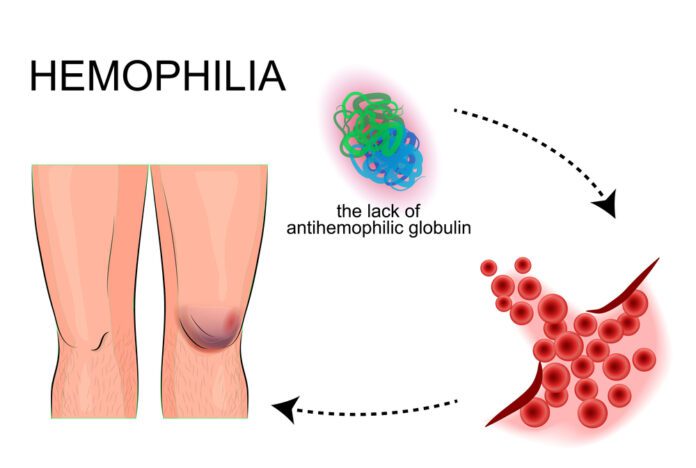Overview Of Hemophilia A
Hemophilia A is an inherited bleeding disorder in which the blood does not clot normally. People with hemophilia A will bleed more than normal after an injury, surgery, or dental procedure. This disorder can be severe, moderate, or mild. In severe cases, heavy bleeding occurs after a minor injury or even when there is no injury (spontaneous bleeding). Bleeding into the joints, muscles, brain, or organs can cause pain and other serious complications. In milder forms, there is no spontaneous bleeding, and the disorder might only be diagnosed after a surgery or serious injury. Hemophilia A is caused by having low levels of a protein called factor VIII. Factor VIII is needed to form blood clots. The disorder is inherited in an X-linked recessive manner and is caused by changes (mutations) in the F8 gene. The diagnosis of hemophilia A is made through clinical symptoms and specific laboratory tests to measure the amount of clotting factors in the blood. The main treatment is replacement therapy, during which clotting factor VIII is dripped or injected slowly into a vein. Hemophilia A mainly affects males. With treatment, most people with this disorder do well. Some people with severe hemophilia A may have a shortened lifespan due to the presence of other health conditions and rare complications of the disorder.
Commonly Associated With
Hemophilia, classic; HEM A; Classic hemophilia; Factor 8 deficiency; Factor VIII deficiency; Classical hemophilia; Haemophilia A; Hemophilia A, congenital
Causes Of Hemophilia A
Hemophilia A is caused by genetic changes (mutations) in the F8 gene. This gene is responsible for making the Factor VIII protein, an important protein that helps start the formation of blood clots. Mutations in the F8 gene lead to reduced or absent levels of Factor VIII in the blood, making it hard for the body to form blood clots.
Symptoms Of Hemophilia A
The symptoms of hemophilia A and the age symptoms appear vary depending on the amount of factor VIII a person’s body makes. Infants with the severe form may bleed abnormally from their mouth and develop ‘goose eggs’ on their heads (collections of blood under the scalp). Other symptoms of the severe form include bleeding without any known cause (spontaneous bleeding) into the muscles, joints, and organs. Children with the moderate form may bruise easily and bleed too much after minor injuries, dental work, or surgery. People with the mild form of hemophilia A may not be diagnosed until they bleed more than normal after a major injury or surgery. With the mild form, there are no episodes of spontaneous bleeds
Exams & Tests
The diagnosis of hemophilia A is made through the clinical symptoms and confirmed by laboratory testing. Blood tests are done to measure the time it takes the blood to clot and the amount of clotting factors found in the blood. Genetic testing can also help determine the exact change in the F8 gene and can be helpful for identifying other family members at risk for hemophilia A.
Treatment Of Hemophilia A
People with inherited hemophilia A require life-long care, preferably through a specialized hemophilia treatment center. These centers are located around the United States and can be found through the Centers for Disease Control and Prevention. The National Hemophilia Foundation has links to management and treatment guidelines.
There is no cure for hemophilia A, but current treatments can prevent many of the symptoms of hemophilia A. Treatment may include medications and replacing the missing clotting factor (replacement therapy). This type of replacement therapy is done by slowly injecting or dripping concentrated factor VIII into a vein (intravenous infusion). The type and frequency of treatment often depend on the severity of the disorder in each person.
People with mild or moderate hemophilia A may be treated with replacement therapy as needed (for example, when a bleeding episode occurs). This is called ‘on-demand therapy. Some people with mild hemophilia A may be treated with desmopressin (DDAVP). Desmopressin raises the levels of factor VIII in the blood and may be given directly into a vein or through a nasal spray. Drugs known as antifibrinolytics, which slow the breakdown of clotting factors in the blood, can also be used to treat a mild form of the disorder.
Some people with severe hemophilia A may receive regular factor VIII replacement therapy to prevent bleeding episodes and other complications such as joint damage. This is referred to as prophylactic or preventative therapy. These factor VIII infusions may be done as often as necessary depending on the severity. The immune system of some people with the severe form of hemophilia A may start to make antibodies (inhibitors) that prevent the replacement factor VIII from working. Treatment for these people includes larger doses of replacement factor VIII and/or medications that may help block the inhibitors.
Infusions of replacement Factor VIII can be given at home. This is especially important for people with severe disease because the infusion works the best within one hour of a bleeding episode. In general, prompt treatment is important because it reduces pain and damage to the joints, muscles, or other affected tissues or organs.



